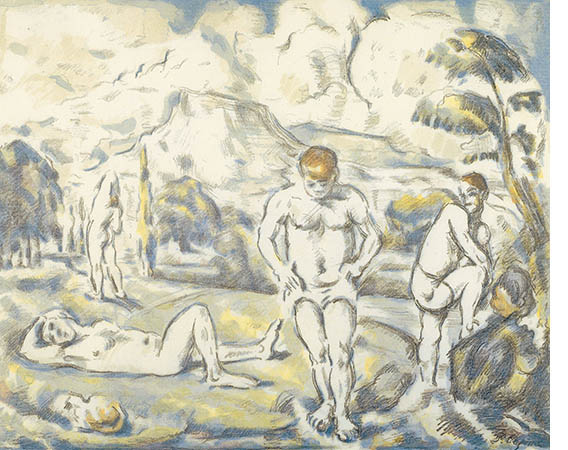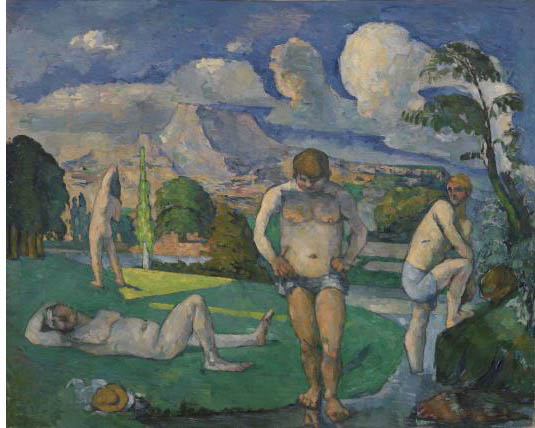 In Paul Cézanne’s lithograph of 1899 “The Bathers”, which I saw in the Stein Collection at the Metropolitan, there is a striking relation between the broad shouldered bather meditatively standing in the foreground and the flat-topped image of Mt. Ste. Victoire and the billowing clouds in the distance. In his essay “Art as Energy”, the poet and philosopher Eli Siegel has written that: “In art, the way is from repose to motion with form to more repose, a greater repose.” As we look, the warm-colored clouds and mountain come forward so that they are on the same plane that the bather is, making the distant near. The effect is thrilling.
In Paul Cézanne’s lithograph of 1899 “The Bathers”, which I saw in the Stein Collection at the Metropolitan, there is a striking relation between the broad shouldered bather meditatively standing in the foreground and the flat-topped image of Mt. Ste. Victoire and the billowing clouds in the distance. In his essay “Art as Energy”, the poet and philosopher Eli Siegel has written that: “In art, the way is from repose to motion with form to more repose, a greater repose.” As we look, the warm-colored clouds and mountain come forward so that they are on the same plane that the bather is, making the distant near. The effect is thrilling. Cézanne had produced this lithograph at the request of dealer Ambrose Vollard, basing it on a painting from the years between 1875 and 1877, “Bathers at Rest” now in the Barnes Collection (below, right). Critics Roger Fry and Erle Loran, both painters who have studied Cézanne’s development from a technical point of view, consider it a notable transitional work.
 Roger Fry writes: “The design is based on rectangular directions and parallelograms and pyramids. And these forms are situated in the picture-space with that impressive definiteness, that imperturbable repose of which Cézanne had discovered the secret.”
Roger Fry writes: “The design is based on rectangular directions and parallelograms and pyramids. And these forms are situated in the picture-space with that impressive definiteness, that imperturbable repose of which Cézanne had discovered the secret.” Imperturbable repose, yes, but also energy seeking a direction. The color in this painting is gorgeous, but Cézanne wanted more. He wanted to go beyond the Renaissance, beyond Impressionism, to find a new synthesis of color and form. In his search for a new relation of color and form the figures and faces have become distorted, because Cézanne was trying to relate the figure to the landscape. In “Art as Energy” Eli Siegel said: “Art is the energy that sees a thing as it is, by seeing it more as it is. Always in energy is the idea of more: energy is more than stillness, more than leaving a thing as it is.”
Cézanne was finding his way. On the right side of the painting he succeeds in bringing the sky and the clouds right up to the picture plane. He told Emile Bernard:
“Today a painter must discover everything for himself, for there are no longer any but very bad schools, where one becomes warped, where one learns nothing.”
 Looking back at the lithograph, we see that Cézanne has arrived at a new relation of repose and energy, matter and space. Roger Fry writes of the artist’s “eye and hand working in total rhythmic response to the rhythms of nature.” Critic Erie Loran writes that distortions of figure are now “completely integrated with the total organization. A moving, rhythmic quality pervades the total space, and the human figures are synthesized with mountains, trees, and clouds.”
Looking back at the lithograph, we see that Cézanne has arrived at a new relation of repose and energy, matter and space. Roger Fry writes of the artist’s “eye and hand working in total rhythmic response to the rhythms of nature.” Critic Erie Loran writes that distortions of figure are now “completely integrated with the total organization. A moving, rhythmic quality pervades the total space, and the human figures are synthesized with mountains, trees, and clouds.”
Through the artist’s hand, in the repeated rhythmic strokes, color and form are related in a new way, and motions of living things, flowing water, tumbled garments, vaulting clouds in turbulent motion are at one with wide green grass and a blue sky. There is a new friendliness of the curved line to the straight lines in the composition – in the bank of a stream, in tree branches that meet a billowing cloud that is at the same time completely flat, in a crown of russet hair. There is the sense of the whole composition being in a circle. Mr. Siegel wrote: “Energy in art, art as energy, takes the withinness of things and makes it outward. When we see what is within a thing as outward, we see that thing as more. And the artist, while he shows what is within a thing as outward, sees himself as within and without, likewise: the deep will be the surface.” We see that the faces and bodies are more abstract now, on a level with the landscape forms, and also more alive, as the penetrating dark strokes for eyes go deep within.
Cézanne had an appetite and love for painting, and looked for form in everything he saw -- in people’s faces, in fleshly bodies, in unyielding rocks, in the atmosphere. He said he wanted to die painting. In "Art as Energy", Eli Siegel wrote: “In art, the excessive is the accurate; the energetic is the proper.” The excess of motion in this lithograph is proper. It relates everything. It does what we want to do, and we feel composed and happy. Eli Siegel defined happiness as “dynamic tranquility” and stated the principle: “All beauty is a making one of opposites, and the making one of opposites is what we are going after in ourselves.”
“Today a painter must discover everything for himself, for there are no longer any but very bad schools, where one becomes warped, where one learns nothing.”
 Looking back at the lithograph, we see that Cézanne has arrived at a new relation of repose and energy, matter and space. Roger Fry writes of the artist’s “eye and hand working in total rhythmic response to the rhythms of nature.” Critic Erie Loran writes that distortions of figure are now “completely integrated with the total organization. A moving, rhythmic quality pervades the total space, and the human figures are synthesized with mountains, trees, and clouds.”
Looking back at the lithograph, we see that Cézanne has arrived at a new relation of repose and energy, matter and space. Roger Fry writes of the artist’s “eye and hand working in total rhythmic response to the rhythms of nature.” Critic Erie Loran writes that distortions of figure are now “completely integrated with the total organization. A moving, rhythmic quality pervades the total space, and the human figures are synthesized with mountains, trees, and clouds.” Through the artist’s hand, in the repeated rhythmic strokes, color and form are related in a new way, and motions of living things, flowing water, tumbled garments, vaulting clouds in turbulent motion are at one with wide green grass and a blue sky. There is a new friendliness of the curved line to the straight lines in the composition – in the bank of a stream, in tree branches that meet a billowing cloud that is at the same time completely flat, in a crown of russet hair. There is the sense of the whole composition being in a circle. Mr. Siegel wrote: “Energy in art, art as energy, takes the withinness of things and makes it outward. When we see what is within a thing as outward, we see that thing as more. And the artist, while he shows what is within a thing as outward, sees himself as within and without, likewise: the deep will be the surface.” We see that the faces and bodies are more abstract now, on a level with the landscape forms, and also more alive, as the penetrating dark strokes for eyes go deep within.
Cézanne had an appetite and love for painting, and looked for form in everything he saw -- in people’s faces, in fleshly bodies, in unyielding rocks, in the atmosphere. He said he wanted to die painting. In "Art as Energy", Eli Siegel wrote: “In art, the excessive is the accurate; the energetic is the proper.” The excess of motion in this lithograph is proper. It relates everything. It does what we want to do, and we feel composed and happy. Eli Siegel defined happiness as “dynamic tranquility” and stated the principle: “All beauty is a making one of opposites, and the making one of opposites is what we are going after in ourselves.”